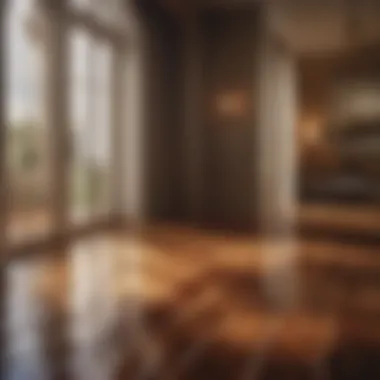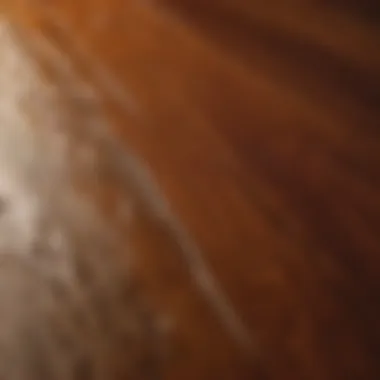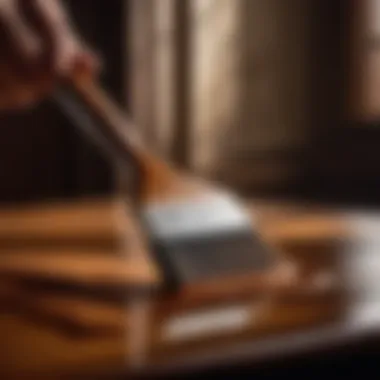Materials:
- Wood stain (1 gallon)
- Waterproof sealant (1 quart)
- Sandpaper (various grits)
- Paintbrushes (different sizes)
- Rags
DIY Steps:
-
Prepare the Surface: Ensure the wood is clean and smooth by sanding it with different grits of sandpaper.
-
Choose the Stain: Select a wood stain color that complements your project.
-
Apply the Stain: Use a paintbrush to apply a generous coat of stain evenly along the wood grain.
-
Let It Dry: Allow the stain to dry completely according to the manufacturer's instructions.
Technical Aspects:
- Tools: Paintbrushes, sandpaper
- Timing: Allow for 24 hours of drying time for the stain
- Techniques: Apply the stain in the direction of the wood grain for a smooth finish
DIY Project Process:


-
Applying the Waterproof Sealant: Once the stain is dry, apply a waterproof sealant using a clean brush.
-
Drying Time: Allow the sealant to dry for at least 48 hours before exposing it to moisture.
-
Troubleshooting Tips: If there are bubbles in the sealant, gently sand them out and reapply.
Introduction


Wood stain and waterproofing are essential techniques for preserving the beauty and longevity of wooden surfaces. In this comprehensive guide to wood stain and waterproofing techniques, we delve into the intricate world of enhancing and protecting wood. Through a meticulous exploration of various products, application methods, benefits, and considerations, this guide serves both beginners and seasoned DIY enthusiasts seeking a flawless finish for their wood projects.
Understanding Wood Stain
Wood stain plays a crucial role in enhancing the natural beauty of wood while providing protection against elements. Understanding the types of wood stains, such as oil-based, water-based, and gel stains, is pivotal in choosing the right one for your project. Each type offers unique characteristics in terms of color depth, ease of application, and durability, catering to different aesthetic and functional needs. By delving into the nuances of wood stain selection, you can achieve desired results that elevate the appearance and durability of your woodwork.
Types of Wood Stains
Types of wood stains vary in composition and application, offering versatility in achieving desired finishes. Oil-based stains penetrate deeply, enhancing the wood's grain and providing rich colors. Water-based stains offer quick drying times and low odor, ideal for indoor projects. Gel stains provide control over color intensity and are suitable for vertical surfaces. Understanding the characteristics of each type empowers you to make informed decisions based on your project requirements, ensuring a successful and long-lasting finish.
Choosing the Right Stain Color
Selecting the right stain color is a creative process that can significantly impact the overall aesthetics of your project. Whether you opt for traditional wood tones or bold contemporary hues, the chosen color should harmonize with the existing decor and enhance the wood's natural features. Consider factors such as wood species, desired finish intensity, and lighting conditions to choose a stain color that achieves your envisioned look and complements your space.
Preparation Tips Before Staining
Proper preparation is key to a successful staining project, ensuring uniform color absorption and adhesion. Before staining, it is essential to sand the wood surface to a smooth finish, free of imperfections and previous coatings. Additionally, applying a pre-stain wood conditioner can help prevent blotchiness and promote even stain application. By investing time in thorough preparation, you set the foundation for a flawless and durable finish that accentuates the beauty of the wood.
Benefits of Waterproofing
Waterproofing wood is a crucial step in safeguarding it against moisture, decay, and rot, prolonging its lifespan and maintaining its appearance. Recognizing the significance of waterproofing wood and exploring different sealant options can elevate the durability and resilience of your wood projects.
Importance of Waterproofing Wood
Wood is susceptible to damage from moisture, making waterproofing a vital protective measure. By applying a waterproof sealant, you create a barrier that shields the wood from water infiltration, preventing warping, cracking, and discoloration. Waterproofed wood exhibits enhanced resistance to environmental factors, ensuring its longevity and maintaining its visual appeal over time.
Types of Waterproof Sealants
A variety of waterproof sealants are available, each offering unique features and benefits. From penetrating oils to film-forming finishes, waterproof sealants come in different formulations suited for various wood types and applications. Understanding the characteristics of sealants like polyurethane, varnish, and marine-grade finishes enables you to choose the most suitable option for your specific project requirements. By selecting the right waterproof sealant, you create a protective shield that fortifies the wood against external elements, preserving its beauty and structural integrity.
Harmonizing Wood Stain and Waterproofing
Harmonizing wood stain and waterproofing products is essential for achieving a cohesive and durable finish that showcases the wood's natural beauty. By ensuring compatibility between stain and sealant products and implementing effective maintenance practices, you can prolong the lifespan of your wood projects and enjoy long-lasting results.
Compatibility of Stain and Waterproofing Products
Compatibility between wood stain and waterproofing products is crucial for ensuring a seamless and durable finish. Using products that are specifically designed to work together enhances adhesion and durability, preventing issues such as peeling or yellowing over time. By selecting compatible products and following manufacturer recommendations, you can create a unified protective layer that enhances the wood's aesthetics and resilience.
Tips for Ensuring Longevity of Finish
Maintaining the longevity of your wood finish requires proactive care and regular upkeep. Implementing preventive measures such as using coasters, avoiding direct sunlight exposure, and promptly addressing spills can mitigate damage and prolong the finish's lifespan. Additionally, scheduling periodic inspections and touch-ups ensures early detection of wear and tear, enabling timely repairs and preservation of the wood's appearance. By incorporating these tips into your maintenance routine, you can enjoy enduring beauty and protection for your stained and waterproofed wood surfaces.
Wood Staining Techniques


In the realm of wood stain and waterproofing, mastering the art of wood staining techniques is of paramount importance. Understanding and implementing the proper techniques can significantly enhance the durability and aesthetics of wood surfaces. This section will delve into the various aspects of wood staining techniques, shedding light on its crucial role in achieving the perfect finish in this comprehensive guide.
Applying Wood Stain
Wood staining is a meticulous process that involves enhancing the natural beauty of wood while providing protective properties. Among the different methods of applying wood stain, each technique offers unique benefits and considerations tailored to specific project requirements.
Brush Application Method
When it comes to applying wood stain, the brush application method stands out for its precision and versatility. This method allows for detailed work, ensuring that the stain is evenly distributed across the wood surface. Moreover, the brush application method offers control over the depth of color saturation, making it a popular choice for intricate projects. However, it is essential to note that brush strokes may be visible, requiring careful technique to achieve a seamless finish.
Spray Application Method
The spray application method provides a quick and efficient way to cover large surface areas with an even coat of stain. Ideal for projects that demand speed and uniform coverage, this method excels in delivering a smooth finish with minimal effort. While spray application expedites the staining process, overspray and uneven application can be challenges to address. Careful masking and controlled spraying techniques are crucial for optimal results.
Cloth Application Method
For a more hands-on approach, the cloth application method offers a tactile experience in applying wood stain. Using a soft cloth, such as a lint-free rag, allows for greater control over the amount of stain applied and enables the user to work the product into the wood grain effectively. This method is particularly suitable for achieving a natural, rustic look while minimizing the risk of drips and blotches. However, the cloth application method may require more time and effort compared to other techniques.
Advanced Staining Techniques
Beyond the conventional methods of applying wood stain, advanced staining techniques present opportunities for creative customization and textural effects. These techniques elevate the aesthetic appeal and character of wood surfaces, offering distinct advantages for discerning DIY enthusiasts.
Layering Stains for Custom Finishes
Layering stains for custom finishes involves the strategic application of multiple layers of stain to create depth and complexity in the wood's appearance. By layering different hues or tones of stain, enthusiasts can achieve unique color variations and visual interest in their projects. This technique allows for personalized creativity and the possibility to mimic premium wood species at a fraction of the cost. However, precise layering and blending techniques are essential to avoid color muddling and achieve the desired result.
Antiquing and Distressing Techniques
Antiquing and distressing techniques add character and aged charm to wood surfaces, replicating the look of vintage or weathered wood. By incorporating techniques such as sanding, glazing, or applying specialty products, wood enthusiasts can achieve a timeworn patina that evokes nostalgia and authenticity. These techniques are popular for creating focal points in interior design schemes and enhancing the rustic appeal of furniture and decor. Careful consideration of the wood species and intended style is crucial to execute antiquing and distressing effectively while preserving the wood's integrity.
Waterproofing Methods
In the realm of woodworking, the significance of waterproofing methods cannot be overstated. Effective waterproofing not only enhances the aesthetic appeal of wood but also protects it from moisture damage, extending its lifespan and durability. When considering waterproofing methods, several key elements come into play. Firstly, choosing the right sealant is crucial. Different types of wood may require specific sealants, so understanding the wood type and the environment it will be exposed to is essential. Furthermore, the application of waterproof sealants plays a vital role in achieving a successful finish. Proper application techniques ensure thorough coverage and penetration, creating a robust protective layer against moisture infiltration. Moreover, considering factors such as weather resistance, UV protection, and ease of maintenance is imperative for selecting the most suitable waterproofing method.
Sealing and Protecting Wood
Applying Waterproof Sealant
When it comes to wood preservation, applying a waterproof sealant is a fundamental step in safeguarding the wood from the elements. A key characteristic of applying waterproof sealant is its ability to form a protective barrier that repels water and prevents moisture absorption. This not only shields the wood from rot and decay but also helps maintain its integrity and natural beauty. One of the primary advantages of using a waterproof sealant is its durability and longevity, providing long-term protection for the wood surface. However, one consideration to bear in mind is the need for proper surface preparation before application to ensure optimal adhesion and effectiveness of the sealant. Overall, applying a waterproof sealant is a popular choice for wood staining and waterproofing, offering a reliable solution for preserving wood structures.
Benefits of Topcoat Sealants
In the realm of wood finishing, topcoat sealants play a crucial role in enhancing the durability and resilience of the wood surface. The key characteristic of topcoat sealants is their ability to provide an additional layer of protection that boosts the waterproofing properties of the wood stain. By applying a topcoat sealant, the wood is shielded from external factors such as UV rays, moisture, and physical abrasions, which can compromise its appearance and structure over time. One notable advantage of topcoat sealants is their versatility, as they come in various formulations suitable for different wood types and environmental conditions. However, one aspect to consider is the potential impact of topcoat sealants on the sheen and color of the wood stain, as certain formulations may alter the final appearance. Despite this, the benefits of using topcoat sealants outweigh any minor drawbacks, making them a preferred choice for enhancing the longevity and performance of wood finishes.
Outdoor Waterproofing
UV Protection for Outdoor Wood
When it comes to outdoor wood structures, UV protection is a critical aspect of waterproofing to prevent premature discoloration and deterioration. The key characteristic of UV protection for outdoor wood is its ability to shield the wood surface from harmful ultraviolet rays, which can cause fading, warping, and degradation of the wood fibers. By applying a UV-protective finish, the wood maintains its natural color and integrity, prolonging its lifespan and visual appeal. One of the unique features of UV protection is its transparent formulation, which allows the wood grain to shine through while providing effective sunblock. While the advantages of UV protection are clear in preserving outdoor wood, regular maintenance and reapplication of the finish may be necessary to ensure continuous protection against UV damage.
Refinishing Weathered Wood
Over time, outdoor wood surfaces are prone to weathering, which can leave them looking worn and aged. Refinishing weathered wood is a revitalizing process that restores the appearance and functionality of outdoor structures. The key characteristic of refinishing weathered wood is its ability to rejuvenate the wood surface by removing dirt, mildew, and old finishes, preparing it for a fresh waterproofing treatment. By refinishing weathered wood, homeowners can breathe new life into their outdoor spaces, enhancing both aesthetics and longevity. One unique feature of this process is the use of specialized wood cleaners and sanding techniques to achieve a smooth and even surface before applying the new finish. While the advantages of refinishing weathered wood are substantial in revitalizing outdoor structures, proper planning and execution are essential to ensure a seamless and durable result.
Maintenance and Care
In this article, the Maintenance and Care section holds immense significance as it plays a crucial role in preserving the longevity and beauty of stained and waterproofed wood. By implementing proper maintenance and care practices, individuals can ensure that their wood surfaces not only maintain their aesthetic appeal but also remain protected from external elements such as moisture, UV rays, and wear and tear. This section focuses on providing readers with valuable insights into how to effectively care for their wood finishes, highlighting specific elements, benefits, considerations, and tips to guarantee the durability and quality of the applied wood stain and waterproofing.
Preserving Stained and Waterproofed Wood
Regular Cleaning Tips
Regular cleaning is a fundamental aspect of maintaining stained and waterproofed wood surfaces. By incorporating regular cleaning routines, individuals can prevent the buildup of dirt, grime, and other contaminants that could potentially damage or discolor the wood finish. Utilizing gentle cleaning solutions and soft microfiber cloths, homeowners can safely remove debris without causing harm to the protective sealants. One key characteristic of regular cleaning tips is their simplicity and effectiveness in preserving the wood's original beauty and finish. Although seemingly basic, regular cleaning tips are a popular choice in this article due to their non-intrusive nature and ability to prolong the lifespan of wood stains and waterproofing products. The unique feature of regular cleaning tips lies in their ability to maintain the wood's integrity without compromising the applied finishes. While there are no significant disadvantages to regular cleaning, the advantages are plentiful, as they contribute significantly to the overall maintenance and care of stained and waterproofed wood.
Reapplication Schedules
Establishing reapplication schedules is essential for ensuring that stained and waterproofed wood surfaces remain adequately protected over time. By adhering to recommended reapplication intervals, individuals can proactively maintain the integrity of the wood finishes and safeguard them against environmental hazards. One of the key characteristics of reapplication schedules is their proactive approach to wood maintenance, preemptively addressing any signs of wear or deterioration in the protective coatings. This method is a beneficial choice for this article as it emphasizes the importance of consistency in preserving stained and waterproofed wood. The unique feature of reapplication schedules lies in their ability to reinforce the protective properties of wood sealants, thereby extending the lifespan of the finishes. While some may view reapplication schedules as time-consuming, the advantages outweigh any potential drawbacks, as they play a vital role in sustaining the beauty and resilience of wood surfaces.
Conclusion
In the realm of wood stain and waterproofing techniques, proper conclusion is essential to summarize the key elements discussed throughout this comprehensive guide. Wrapping up the knowledge shared from the introductory stages to the application processes, the conclusion serves a crucial role in reinforcing the importance of meticulous planning, execution, and maintenance in achieving impeccable results. By revisiting the fundamental concepts covered in understanding wood stains, benefits of waterproofing, harmonizing techniques, staining methods, waterproofing practices, and maintenance tips, readers are reminded of the intricate balance required to master the art of wood finishing.
With a focus on achieving wood staining perfection, this section emphasizes the critical role of attention to detail, selection of high-quality products, and adherence to best practices for enduring results. By integrating key takeaways for successful staining, individuals can gain a comprehensive understanding of the nuances involved in enhancing the natural beauty of wood surfaces. These takeaways encapsulate the significance of proper surface preparation, choosing compatible stain colors, and preserving the finish through regular maintenance routines.
Furthermore, delving into sustainable waterproofing practices sheds light on the eco-friendly options available for sealing and protecting wood surfaces. By prioritizing environmentally conscious solutions, homeowners can not only safeguard their wooden structures but also contribute to a greener future. Sustainable waterproofing practices highlight the importance of using biodegradable and non-toxic sealants that provide long-lasting protection without compromising the integrity of the wood.





